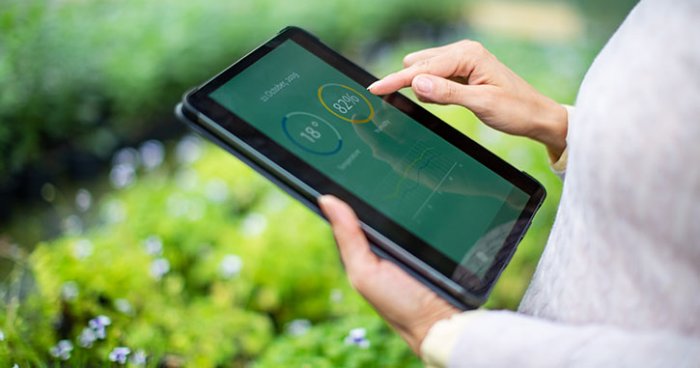
The whole ecosystem's acculturation to the ecological advantages of circular economy practices is one of the challenges for developing an environmentally friendly digital economy.
The global health crisis has placed health at the heart of societal challenges. It has demonstrated the fragility of our economic, social and environmental development model, and highlighted the need for a soberer, more responsible and sustainable consumption of our natural resources. By taking up the challenges of the circular economy, digital players have the opportunity to expedite the ecological transition and contribute to the emergence of a more sustainable and virtuous post-crisis system.
A paradigm shift is essential
Digital only represents 3.5% of greenhouse gas (GHG) emissions in the world. However, without corrective actions, the deployment of new networks, the proliferation of terminals and the explosion of uses, boosted by 5G, will significantly increase these emissions. The energy consumption of operators will rise, and so will the production of electronic and electrical equipment, which life cycle - from manufacturing to disposal - accounts for 70% of the carbon footprint of digital technology. Indeed, waste from electronic and electrical equipment (WEEE) is not recycled enough, even though it contains rare natural resources (gold, silver, copper, platinum, etc.). Its global volume increases by 2.5 million tons each year! This increase poses a growing environmental and health risk that operators cannot ignore.
WEEE key figures
In 2019, the world generated 53.6 million tons of waste from electrical and electronic equipment (WEEE): 7.3 kg per person and +21% growth in 5 years.
Breakdown: 24.9 Mt in Asia, 13.1 in the Americas, 12 in Europe, 2.9 in Africa and 0.7 in Oceania.
Only 17.4% of this WEEE is collected and recycled, particularly in Europe (42.5% of the total volume).
Outlook for 2030: 74.7 Mt of WEEE, twice as much as in 2005.
Source: Global E-Waste Monitor
The circular economy, a virtuous circle
To promote sustainable and environmentally friendly digital growth, the European Commission, governments and various organizations such as the ITU or the National Institute for the Circular Economy (INEC) and the French Agency for the Environment and Energy Management (ADEME), are promoting the circular economy and providing it with a regulatory framework.
What is the circular economy?
It seeks to accelerate the transformation of our production and consumption model by promoting the reuse of natural resources and limiting the production of waste. It aims at an end-to-end control of the life cycle of products and services in a virtuous cycle of raw material. It contributes to moving from "disposable" consumption to "sustainable" consumption.
Thus, the anti-waste law for a circular economy (AGEC), enacted in France on February 10, 2020, requires electronic equipment manufacturers to inform consumers about the environmental characteristics of their products (product reparability and durability indications, availability of spare parts...). As for operators, they will be obliged to inform their customers about the carbon cost of their digital consumption as of January 2022.
A strategic lever in favor of zero carbon goal and a successful business model
Some operators are already well engaged in the fight against waste, the reuse of dormant equipment stocks, and recycling. For instance, circular economy is one of the pillars of Orange’s "engage 2025" strategy that aim to achieve "Zero Carbon" by 2040. It has launched several programs that reflect measurable objectives and visibility to various initiatives in Europe and Africa:
- An ecodesign process for Orange brand products.
- Collection and recycling of used phones: 100 million are said to be sleeping in the drawers of French people! Takeback-repair-reconditioning of functional smartphones ("Re" program). Objectives 2025 in Europe: collect 30% of the number of mobiles sold. Generate 10% of sales volume from refurbished phones.
- The collecting of 90% of fixed terminals in case of termination (boxes...).
- The use of reconditioned network infrastructure and IT equipment. To do this, Orange has created Marketis, an internal platform for the purchase and sale of infrastructure, enabling for example subsidiaries wishing to deploy 3G or 4G in Africa to reuse equipment dismantled in Europe. This is a very efficient business model: it avoids the production of new equipment, thus reducing CO2 emissions and the operator's investment costs, while providing quality: repaired and retested, this equipment proves to be very reliable to be used.
An operational challenge
Integrating the circular economy into its CSR strategy and objectives is a pre-requisite for success, however not sufficient. Operators evolve in a complex and globalized ecosystem. One of their major challenges is to engage OEMs and alternative suppliers, who are often reluctant, in a reconditioning approach in favor of using second-hand equipment. Faced with this resistance, operators are establishing consortiums to focus their efforts in the same direction:
- Creation of an interoperator marketplace for functional used equipment.
- The Joint Audit CoOperation (JAC) brings together 17 operators to improve CSR and sustainability standards in the supply chain.
In parallel, a market of alternative suppliers such as Morphosis, Cordon, Itancia and many others, is emerging. It allows the recycling of WEEE and the reconditioning of ICT equipment.
This is the beginning of a long battle to be fought... The definition of standards and the reinforcement of the regulatory framework are essential to ensure the traceability, throughout the life cycle, of a wide range of products and to identify the eco-responsibility of the participants in the chain (manufacturer, operator, end user). The Eco Rating that Deutsche Telekom, Orange Telefonica, Telia Company and Vodafone have developed and launched on June 1, 2021 is relevant. The index allows consumers to identify the most environmentally friendly cellphones, while encouraging suppliers to reduce the environmental impact of their products.
A cultural challenge
Acculturating the entire ecosystem to the ecological benefits of circular economy practices is another major challenge. The operator has a role to play, alongside governments and agencies, in raising awareness among its suppliers, customers and employees. Even if practices are evolving - nearly a quarter of French people have already bought a second-hand smartphone 1 - much remains to be done to promote sober consumption of digital uses and support the transformation.
Over 10 years ago, Orange launched a number of awareness-raising initiatives in this area: quizzes, games, a circular economy passport, a presentation of its "re" program in its stores, advice to its customers, indicators on the carbon impact of mobile internet usage, "energy saving" settings for its services (box, TV), implementation of anti-waste gestures on a daily basis within the company, or at Sofrecom, integration of sustainable environment engineers, etc.
Conclusion
At the peak of the pandemic, digital technology was proven to be a pillar for improving our daily lives and even a driver for decarbonization in certain activities. Its programmed growth is an opportunity for an operator concerned about its environmental footprint to commit to a new model of sustainable development. The circular economy is not just a set of constraints to limit the use of natural resources and preserve the planet. It is also a virtuous economic and social model: it optimizes costs while improving the quality of products ; it promotes the digital inclusion by facilitating digital access for all.
1 IFOP 2019 survey for SOFI Group






